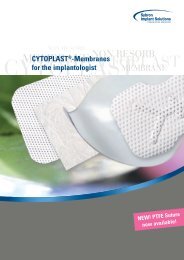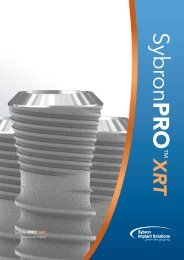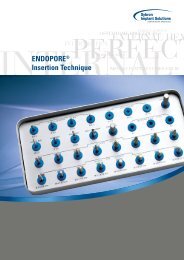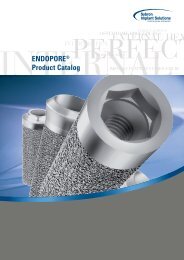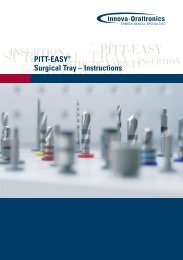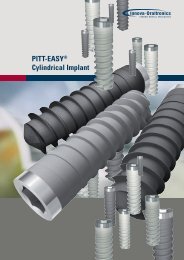BIORESORB® Macro Pore Augmentation material - Optident
BIORESORB® Macro Pore Augmentation material - Optident
BIORESORB® Macro Pore Augmentation material - Optident
Create successful ePaper yourself
Turn your PDF publications into a flip-book with our unique Google optimized e-Paper software.
BIORESORB ® <strong>Macro</strong> <strong>Pore</strong><br />
<strong>Augmentation</strong> <strong>material</strong>
BIORESORB ® <strong>Macro</strong> <strong>Pore</strong><br />
<strong>Augmentation</strong> <strong>material</strong><br />
BIORESORB ® <strong>Macro</strong> <strong>Pore</strong><br />
Helps<br />
create bone<br />
New micro and macro porous 99% ß-Tricalcium phosphate<br />
ceramics as bone regeneration <strong>material</strong><br />
Non-autogenous bone<br />
replacement <strong>material</strong>s for<br />
guided bone regeneration<br />
find increasing acceptance.<br />
The development of these<br />
<strong>material</strong>s have been constantly<br />
adapted to the latest<br />
scientific knowledge, as they<br />
show clear advantages as<br />
compared to other <strong>material</strong>s.<br />
In the meantime, advancements<br />
have progressed<br />
to create a new patented<br />
process for the manufacture<br />
of porous <strong>material</strong>s which are<br />
very similar to bone.
<strong>Augmentation</strong> <strong>material</strong><br />
BIORESORB ® <strong>Macro</strong> <strong>Pore</strong><br />
<strong>Macro</strong> and micro pores<br />
Why Bioresorb<br />
<strong>Macro</strong> <strong>Pore</strong>?<br />
With Bioresorb <strong>Macro</strong> <strong>Pore</strong><br />
you are applying a <strong>material</strong><br />
which derives from pure<br />
synthetic chemicals. This<br />
pure-phase ß-Tricalcium<br />
phosphate (99%) shows a<br />
crystalline structure which<br />
has optimal biological<br />
properties and is 100%<br />
resorbable. The <strong>material</strong><br />
can be easily applied by<br />
any dentist in all indication<br />
situations.<br />
• Synthetic <strong>material</strong>s have<br />
absolutely no remaining<br />
risk of transfer of possible<br />
bacteria or of foreign body<br />
rejection.<br />
• Important: There is no<br />
requirement for patient<br />
information. This saves a<br />
considerable amount of<br />
your time.<br />
• Record result: The macroporous<br />
<strong>material</strong> can be<br />
easily applied similar to<br />
autogenous bone<br />
• The structure of Bioresorb<br />
<strong>Macro</strong> <strong>Pore</strong> is similar to<br />
natural bone. Complete<br />
vascularization is<br />
guaranteed by the optimal<br />
interconnecting porosity<br />
• An extremely high<br />
immediate stability of the<br />
granules in the defect is<br />
secured<br />
Interconnecting porosity<br />
The open and interconnecting<br />
porosity of the granules<br />
enable bone growth over the<br />
complete osteon structures. In<br />
addition, the <strong>material</strong> shows<br />
an exceptional capillary<br />
suction property.<br />
Osteoconductive<br />
Bioresorb <strong>Macro</strong> <strong>Pore</strong> allows<br />
bone to directly grow into the<br />
interconnecting pores prior<br />
to the resorption process.<br />
Bioresorb <strong>Macro</strong> <strong>Pore</strong><br />
functions as guidance for new<br />
bone formation.<br />
Biocompatible<br />
The high biocompatibility<br />
of ß-Tricalcium phosphate<br />
(ß-TCP) was documented<br />
in numerous studies. There<br />
were no unfavorable tissue<br />
reactions nor immunologic<br />
reactive rejections. Bioresorb<br />
<strong>Macro</strong> <strong>Pore</strong> displays a very<br />
high integration within the<br />
natural bone without any<br />
soft tissue encapsulation or<br />
pathological reactions. There<br />
was no evidence of osteoclast<br />
activity.<br />
Complete resorption<br />
The resorption rate of<br />
Bioresorb <strong>Macro</strong> <strong>Pore</strong> is<br />
similar to the rate of new bone<br />
growth. The resorption of the<br />
ß-TCP occurs simultaneously<br />
with the formation of new<br />
natural bone within the<br />
augmentation site, depending<br />
upon the regeneration<br />
dynamics.<br />
Insertion of implants<br />
immediately post-extraction<br />
The prospective success<br />
of the therapy is increased<br />
considerably by the application<br />
of Bioresorb <strong>Macro</strong><br />
<strong>Pore</strong> after immediate implant<br />
insertion or if applied in an<br />
alveolar defect.
BIORESORB ® <strong>Macro</strong> <strong>Pore</strong><br />
<strong>Augmentation</strong> <strong>material</strong><br />
Traces<br />
of the<br />
truth<br />
The percentage of micropores<br />
of an average size of 5 µm and<br />
the percentage of macropores<br />
with an average size of 500 µm<br />
is 30 volume percent each.<br />
The size interval of the micropores<br />
is 0.5 – 10 µm, and that<br />
of the macropores is 50 – 700<br />
µm. The high porosity enhances<br />
an improved dynamic<br />
regeneration as compared<br />
to other bone augmentation<br />
<strong>material</strong>s. The homogenous<br />
structure of macro and micropores<br />
offers a high capillary<br />
function, and the considerably<br />
larger surface can be soaked<br />
with more blood particles and<br />
cells of osteogenous potential.<br />
The pore structure allows<br />
more room for vascularization<br />
than other augmentation<br />
<strong>material</strong>s and provides an<br />
improved nutrition of the<br />
regenerative <strong>material</strong>. The<br />
considerably larger surface<br />
offers more contact for<br />
cellular resorption, resulting<br />
in a shorter resorption time.<br />
The interconnecting micropore<br />
system of the granules<br />
and especially the macropores<br />
are connected by a<br />
collagenous fiber network,<br />
along with sufficient blood<br />
vessels. The collagenous<br />
fibers function as guidance<br />
for the vessels as well as<br />
the newly formed bone, this<br />
stimulating the direct apposition<br />
of bone on the surfaces
<strong>Augmentation</strong> <strong>material</strong><br />
BIORESORB ® <strong>Macro</strong> <strong>Pore</strong><br />
99% phase-free ß-Tricalcium phosphate ceramics<br />
A new generation of pure-phase bioresorbable ß-Tricalcium<br />
phosphate ceramics was created by an innovative manufacturing<br />
process. The <strong>material</strong> consists of an interconnecting<br />
porosity system with macro and micro pores.<br />
SEM magnification x 100 of Bioresorb <strong>Macro</strong> <strong>Pore</strong><br />
SEM magnification x 10,000 of Bioresorb <strong>Macro</strong> <strong>Pore</strong><br />
of the granules prior to the<br />
start of resorption. The macropores<br />
facilitate the ingrowth<br />
of bone into the <strong>material</strong>, the<br />
osteones grow into the upper<br />
layers of the bone augmentation<br />
<strong>material</strong>. The bone regeneration<br />
<strong>material</strong> Bioresorb<br />
<strong>Macro</strong> <strong>Pore</strong> is resorbed<br />
completely, simultaneously<br />
with new bone growth and<br />
allows an accelerated<br />
regeneration of the natural<br />
vital bone at the defect site.<br />
The new ß-Tricalcium phosphate<br />
ceramic <strong>material</strong> has<br />
osteoconductive properties<br />
based on the micro and<br />
macroporous structure which<br />
enable bone defects which<br />
would normally not heal in a<br />
sufficient way, to regenerate<br />
well in good bone quality so<br />
that an immediate or a later<br />
implant insertion is possible.<br />
Despite the high porosity,<br />
Bioresorb <strong>Macro</strong> <strong>Pore</strong> has an<br />
optimal improved stability<br />
and high resistance against<br />
abrasion. The phase-purity<br />
provides a stable structure<br />
and homogenous resorption<br />
ability in time under physio
BIORESORB ® <strong>Macro</strong> <strong>Pore</strong><br />
<strong>Augmentation</strong> <strong>material</strong><br />
With an increasing defect size<br />
the pace of bone regeneration<br />
decreases, since the regeneration<br />
process is not based on<br />
a linear reaction. Therefore,<br />
please note that the defects<br />
with a maximum volume of<br />
less than 1.5 cm require three<br />
months, defects with a size<br />
between 1.5 cm and 2.5 cm six<br />
months, and defects of more<br />
than 2.5 cm nine months for<br />
complete bony regeneration.<br />
Note<br />
Bioresorb <strong>Macro</strong> <strong>Pore</strong> should<br />
be used only by a dentist or<br />
physician who is familiar with<br />
oral implantology and augmentation<br />
techniques. It is recommended<br />
to use Bioresorb<br />
<strong>Macro</strong> <strong>Pore</strong> in a moist state.<br />
The mass of the individual<br />
granules adheres and allows<br />
an easier application into the<br />
defect than in dry state. For<br />
moistening, a sterile isotonic<br />
saline solution can be used,<br />
better is autogenous blood of<br />
the patient or blood plasma<br />
(PRP – platelet rich plasma).<br />
If there is a risk of infection,<br />
combine with antibiotics. If the<br />
defect is larger than 2 cm, we<br />
recommend to use a mixture<br />
of Bioresorb <strong>Macro</strong> <strong>Pore</strong> with<br />
autogenous bone if harvesting<br />
is anatomically possible.<br />
When applying the <strong>material</strong>,<br />
do not compress to save the<br />
interconnecting porosity, but<br />
spread evenly in the defect<br />
and fill completely. The<br />
granule sizes to be used is<br />
depending on the size of the<br />
defect. In general, the larger<br />
the defect, the larger the<br />
granule size. Once the bone<br />
defect has been densely filled<br />
up to the edges by using a<br />
spoon or spatula – depending<br />
on the size – the site is closed<br />
using the usual suture technique.<br />
The covering gingiva<br />
periost flap should achieve primary<br />
closure without<br />
tension so that no granules<br />
can be washed out. If primary<br />
closure is not possible, we<br />
recommend the use of a nonresorbably<br />
Cytoplast membrane,<br />
according to the situation<br />
and following the instructions<br />
for use for membrane technique.<br />
The augmented site<br />
should not be loaded during<br />
the initial healing phase (i.e.<br />
do not use temporary prostheses<br />
or bridges on temporary<br />
implants, etc.).
<strong>Augmentation</strong> <strong>material</strong><br />
BIORESORB ® <strong>Macro</strong> <strong>Pore</strong><br />
Granula sizes<br />
For each indication, Bioresorb <strong>Macro</strong> <strong>Pore</strong> is<br />
available in an optimal granule size:<br />
200 – 500 µm<br />
Periodontal defects and other<br />
defects of small size<br />
500 – 1000 µm<br />
for alveolar defects, small and<br />
medium size cysts<br />
1000 – 2000 µm<br />
for sinus lift of normal<br />
extension<br />
1400 – 3200 µm<br />
for augmentation of large<br />
cysts and extended sinus<br />
elevation<br />
Granule size Vial contents Order No.<br />
200 – 500 µm 1 x 0.5 ml 2105<br />
500 – 1000 µm 1 x 0.5 ml 5105<br />
1 x 1.0 ml 5110<br />
1 x 2.0 ml 5120<br />
1000 – 2000 µm 1 x 0.5 ml 10105<br />
1 x 1.0 ml 10110<br />
1 x 2.0 ml 10120<br />
Set<br />
200 – 500 µm 5 x 0.5 ml 2505<br />
500 – 1000 µm 5 x 0.5 ml 5505<br />
5 x 1.0 ml 5510<br />
5 x 2.0 ml 5520<br />
1000 – 2000 µm 5 x 0.5 ml 10505<br />
5 x 1.0 ml 10510<br />
5 x 2.0 ml 10520<br />
Sinus lift<br />
1400 – 3200 µm 1 x 1.0 ml 14110<br />
1 x 2.0 ml 14120
BIORESORB ® <strong>Macro</strong> <strong>Pore</strong><br />
Sybron Implant Solutions<br />
A World of Implant Solutions<br />
The dental implant platform of Sybron Dental Specialties (SDS)<br />
brings together three (INNOVA – ORALTRONICS – ATTACHMENTS)<br />
organizations that have been leaders in implant manufacturing,<br />
design and development since the inception of implant dentistry.<br />
With our most respected, innovative implant systems – PITT-EASY ® ,<br />
and ENDOPORE ® – we are giving you access to a world of implant<br />
solutions.<br />
BIOVISION GmbH<br />
Am Vogelherd 52<br />
98693 Illmenau<br />
Distributed by:<br />
Sybron Implant Solutions GmbH<br />
Julius-Bamberger-Straße 8a · 28279 Bremen · Germany<br />
Phone +49 421 43939-0 · Fax +49 421 443936<br />
www.sybronimplants.de · info@sybronimplants.de<br />
08-0336: 12/08



